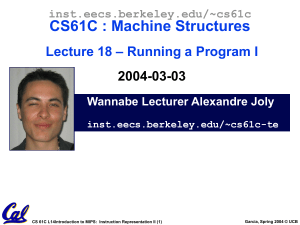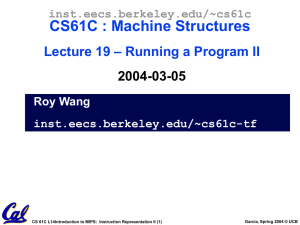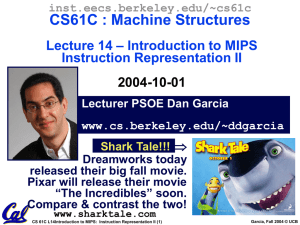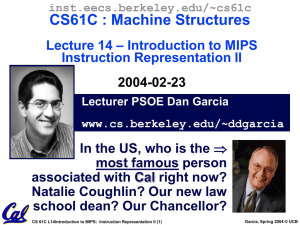L18-L19-runningprogr..
advertisement
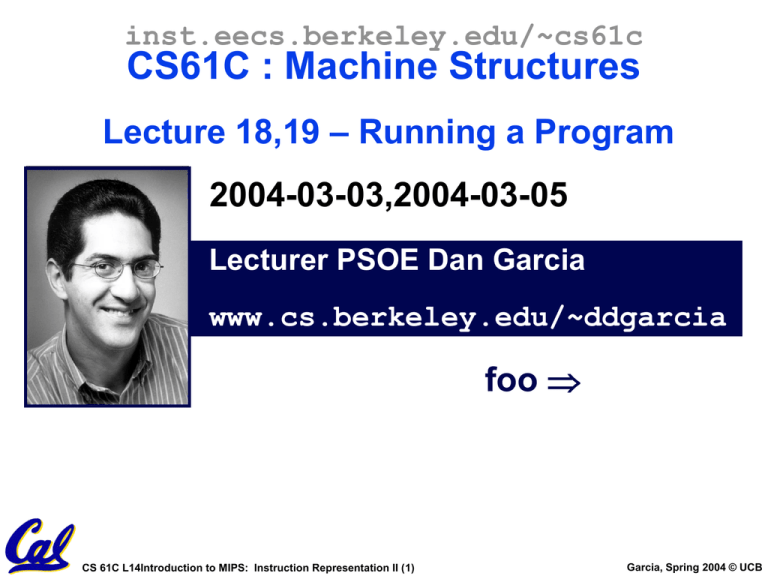
inst.eecs.berkeley.edu/~cs61c
CS61C : Machine Structures
Lecture 18,19 – Running a Program
2004-03-03,2004-03-05
Lecturer PSOE Dan Garcia
www.cs.berkeley.edu/~ddgarcia
foo
CS 61C L14Introduction to MIPS: Instruction Representation II (1)
Garcia, Spring 2004 © UCB
Overview
• Interpretation vs Translation
• Translating C Programs
• Compiler
• Assembler
• Linker
• Loader
• An Example
CS 61C L14Introduction to MIPS: Instruction Representation II (2)
Garcia, Spring 2004 © UCB
Administrivia
• foo
CS 61C L14Introduction to MIPS: Instruction Representation II (3)
Garcia, Spring 2004 © UCB
Language Continuum
Scheme
Java
C++
Java bytecode
C
Assembly
Easy to program
Inefficient to interpret
machine language
Efficient
Difficult to program
• In general, we interpret a high level
language if efficiency is not critical or
translated to a lower level language to
improve performance
CS 61C L14Introduction to MIPS: Instruction Representation II (4)
Garcia, Spring 2004 © UCB
Interpretation vs Translation
• How do we run a program written in a
source language?
• Interpreter: Directly executes a
program in the source language
• Translator: Converts a program from
the source language to an equivalent
program in another language
• For example, consider a Scheme
program foo.scm
CS 61C L14Introduction to MIPS: Instruction Representation II (5)
Garcia, Spring 2004 © UCB
Interpretation
Scheme program: foo.scm
Scheme Interpreter
CS 61C L14Introduction to MIPS: Instruction Representation II (6)
Garcia, Spring 2004 © UCB
Translation
Scheme program: foo.scm
Scheme Compiler
Executable(mach lang pgm): a.out
Hardware
°Scheme Compiler is a translator from
Scheme to machine language.
CS 61C L14Introduction to MIPS: Instruction Representation II (7)
Garcia, Spring 2004 © UCB
Interpretation
• Any good reason to interpret machine
language in software?
• SPIM – useful for learning / debugging
• Apple Macintosh conversion
• Switched from Motorola 680x0
instruction architecture to PowerPC.
• Could require all programs to be retranslated from high level language
• Instead, let executables contain old
and/or new machine code, interpret old
code in software if necessary
CS 61C L14Introduction to MIPS: Instruction Representation II (8)
Garcia, Spring 2004 © UCB
Interpretation vs. Translation?
• Easier to write interpreter
• Interpreter closer to high-level, so gives
better error messages (e.g., SPIM)
• Translator reaction: add extra information
to help debugging (line numbers, names)
• Interpreter slower (10x?) but code is
smaller (1.5X to 2X?)
• Interpreter provides instruction set
independence: run on any machine
• Apple switched to PowerPC. Instead of
retranslating all SW, let executables
contain old and/or new machine code,
interpret old code in software if necessary
CS 61C L14Introduction to MIPS: Instruction Representation II (9)
Garcia, Spring 2004 © UCB
Steps to Starting a Program
C program: foo.c
Compiler
Assembly program: foo.s
Assembler
Object(mach lang module): foo.o
Linker
lib.o
Executable(mach lang pgm): a.out
Loader
Memory
CS 61C L14Introduction to MIPS: Instruction Representation II (10)
Garcia, Spring 2004 © UCB
Compiler
• Input: High-Level Language Code
(e.g., C, Java such as foo.c, foo.s)
• Output: Assembly Language Code
(e.g., foo.s for MIPS)
• Note: Output may contain
pseudoinstructions
• Pseudoinstructions: instructions that
assembler understands but not in
machine (last lecture) For example:
• mov $s1, $s2 = or $s1, $s2, $zero
CS 61C L14Introduction to MIPS: Instruction Representation II (11)
Garcia, Spring 2004 © UCB
Where Are We Now?
C program: foo.c
Compiler
Assembly program: foo.s
Assembler
Object(mach lang module): foo.o
Linker
lib.o
Executable(mach lang pgm): a.out
Loader
Memory
CS 61C L14Introduction to MIPS: Instruction Representation II (12)
Garcia, Spring 2004 © UCB
Assembler
• Input: Assembly Language Code
(e.g., foo.s for MIPS)
• Output: Object Code, information tables
(e.g., foo.o for MIPS)
• Reads and Uses Directives
• Replace Pseudoinstructions
• Produce Machine Language
• Creates Object File
CS 61C L14Introduction to MIPS: Instruction Representation II (13)
Garcia, Spring 2004 © UCB
Assembler Directives (p. A-51 to A-53)
• Give directions to assembler, but do not
produce machine instructions
.text: Subsequent items put in user text
segment
.data: Subsequent items put in user data
segment
.globl sym: declares sym global and can
be referenced from other files
.asciiz str: Store the string str in
memory and null-terminate it
.word w1…wn: Store the n 32-bit quantities
in successive memory words
CS 61C L14Introduction to MIPS: Instruction Representation II (14)
Garcia, Spring 2004 © UCB
Pseudoinstruction Replacement
• Asm. treats convenient variations of machine
language instructions as if real instructions
Pseudo:
Real:
subu $sp,$sp,32
addiu $sp,$sp,-32
sd $a0, 32($sp)
sw $a0, 32($sp)
sw $a1, 36($sp)
mul $t7,$t6,$t5
mul $t6,$t5
mflo $t7
addu $t0,$t6,1
addiu $t0,$t6,1
ble $t0,100,loop
slti $at,$t0,101
bne $at,$0,loop
la $a0, str
lui $at,left(str)
ori $a0,$at,right(str)
CS 61C L14Introduction to MIPS: Instruction Representation II (15)
Garcia, Spring 2004 © UCB
Producing Machine Language (1/2)
• Simple Case
• Arithmetic, Logical, Shifts, and so on.
• All necessary info is within the
instruction already.
• What about Branches?
• PC-Relative
• So once pseudoinstructions are replaced
by real ones, we know by how many
instructions to branch.
• So these can be handled easily.
CS 61C L14Introduction to MIPS: Instruction Representation II (16)
Garcia, Spring 2004 © UCB
Producing Machine Language (2/2)
• What about jumps (j and jal)?
• Jumps require absolute address.
• What about references to data?
•la gets broken up into lui and ori
• These will require the full 32-bit address
of the data.
• These can’t be determined yet, so we
create two tables…
CS 61C L14Introduction to MIPS: Instruction Representation II (17)
Garcia, Spring 2004 © UCB
Symbol Table
• List of “items” in this file that may be
used by other files.
• What are they?
• Labels: function calling
• Data: anything in the .data section;
variables which may be accessed across
files
• First Pass: record label-address pairs
• Second Pass: produce machine code
• Result: can jump to a later label without
first declaring it
CS 61C L14Introduction to MIPS: Instruction Representation II (18)
Garcia, Spring 2004 © UCB
Relocation Table
• List of “items” for which this file
needs the address.
• What are they?
• Any label jumped to: j or jal
- internal
- external (including lib files)
• Any piece of data
- such as the la instruction
CS 61C L14Introduction to MIPS: Instruction Representation II (19)
Garcia, Spring 2004 © UCB
Object File Format
• object file header: size and position of
the other pieces of the object file
• text segment: the machine code
• data segment: binary representation of
the data in the source file
• relocation information: identifies lines
of code that need to be “handled”
• symbol table: list of this file’s labels
and data that can be referenced
• debugging information
CS 61C L14Introduction to MIPS: Instruction Representation II (20)
Garcia, Spring 2004 © UCB
Where Are We Now?
C program: foo.c
Compiler
Assembly program: foo.s
Assembler
Object(mach lang module): foo.o
Linker
lib.o
Executable(mach lang pgm): a.out
Loader
Memory
CS 61C L14Introduction to MIPS: Instruction Representation II (21)
Garcia, Spring 2004 © UCB
Link Editor/Linker (1/3)
• Input: Object Code, information tables
(e.g., foo.o for MIPS)
• Output: Executable Code
(e.g., a.out for MIPS)
• Combines several object (.o) files into
a single executable (“linking”)
• Enable Separate Compilation of files
• Changes to one file do not require
recompilation of whole program
- Windows NT source is >40 M lines of code!
• Link Editor name from editing the “links”
in jump and link instructions
CS 61C L14Introduction to MIPS: Instruction Representation II (22)
Garcia, Spring 2004 © UCB
Link Editor/Linker (2/3)
.o file 1
text 1
data 1
info 1
Linker
.o file 2
text 2
data 2
info 2
CS 61C L14Introduction to MIPS: Instruction Representation II (23)
a.out
Relocated text 1
Relocated text 2
Relocated data 1
Relocated data 2
Garcia, Spring 2004 © UCB
Link Editor/Linker (3/3)
• Step 1: Take text segment from each .o
file and put them together.
• Step 2: Take data segment from each
.o file, put them together, and
concatenate this onto end of text
segments.
• Step 3: Resolve References
• Go through Relocation Table and handle
each entry
• That is, fill in all absolute addresses
CS 61C L14Introduction to MIPS: Instruction Representation II (24)
Garcia, Spring 2004 © UCB
Four Types of Addresses
• PC-Relative Addressing (beq, bne):
never relocate
• Absolute Address (j, jal): always
relocate
• External Reference (usually jal):
always relocate
• Data Reference (often lui and ori):
always relocate
CS 61C L14Introduction to MIPS: Instruction Representation II (25)
Garcia, Spring 2004 © UCB
Resolving References (1/2)
• Linker assumes first word of first text
segment is at address 0x00000000.
• Linker knows:
• length of each text and data segment
• ordering of text and data segments
• Linker calculates:
• absolute address of each label to be
jumped to (internal or external) and each
piece of data being referenced
CS 61C L14Introduction to MIPS: Instruction Representation II (27)
Garcia, Spring 2004 © UCB
Resolving References (2/2)
• To resolve references:
• search for reference (data or label) in all
symbol tables
• if not found, search library files
(for example, for printf)
• once absolute address is determined, fill
in the machine code appropriately
• Output of linker: executable file
containing text and data (plus header)
CS 61C L14Introduction to MIPS: Instruction Representation II (28)
Garcia, Spring 2004 © UCB
Where Are We Now?
C program: foo.c
Compiler
Assembly program: foo.s
Assembler
Object(mach lang module): foo.o
Linker
lib.o
Executable(mach lang pgm): a.out
Loader
Memory
CS 61C L14Introduction to MIPS: Instruction Representation II (29)
Garcia, Spring 2004 © UCB
Loader (1/3)
• Input: Executable Code
(e.g., a.out for MIPS)
• Output: (program is run)
• Executable files are stored on disk.
• When one is run, loader’s job is to
load it into memory and start it
running.
• In reality, loader is the operating
system (OS)
• loading is one of the OS tasks
CS 61C L14Introduction to MIPS: Instruction Representation II (30)
Garcia, Spring 2004 © UCB
Loader (2/3)
• So what does a loader do?
• Reads executable file’s header to
determine size of text and data
segments
• Creates new address space for
program large enough to hold text and
data segments, along with a stack
segment
• Copies instructions and data from
executable file into the new address
space (this may be anywhere in
memory)
CS 61C L14Introduction to MIPS: Instruction Representation II (31)
Garcia, Spring 2004 © UCB
Loader (3/3)
• Copies arguments passed to the
program onto the stack
• Initializes machine registers
• Most registers cleared, but stack pointer
assigned address of 1st free stack
location
• Jumps to start-up routine that copies
program’s arguments from stack to
registers and sets the PC
• If main routine returns, start-up routine
terminates program with the exit system
call
CS 61C L14Introduction to MIPS: Instruction Representation II (32)
Garcia, Spring 2004 © UCB
Peer Instruction
• Which of the following instructions may
need to be edited during link phase?
Loop:
lui
ori
jal
bne
$at, 0xABCD
$a0,$at, 0xFEDC
add_link
$a0,$v0, Loop
#
#
#
#
a
b
c
d
A. a. only
B. b. only
C. c. only
D. d. only
E. a., b., and c.
F. All of the above
CS 61C L14Introduction to MIPS: Instruction Representation II (33)
Garcia, Spring 2004 © UCB
Peer Instruction
• Which of the following instructions may
need to be edited during link phase?
Loop:
lui
ori
jal
bne
$at, 0xABCD
$a0,$at, 0xFEDC
add_link
$a0,$v0, Loop
#
#
#
#
a
b} data reference; relocate
c subroutine; relocate
d PC-relative branch; OK
A. a. only
B. b. only
C. c. only
D. d. only
E. a., b., and c.
F. All of the above
CS 61C L14Introduction to MIPS: Instruction Representation II (34)
Garcia, Spring 2004 © UCB
Reading Quiz
•
K&R talks about the C preprocessor, but
Figure 3.21 on doesn't mention it. What
is the purpose of the C preprocessor?
What language is its input ? What is its
output? If it were a separate step, where
would it be placed relative to the other 4
steps?
C program: foo.c
Compiler
Assembly program: foo.s
Assembler
•
Object(mach lang module): foo.o
Some earlier computers combined the
first three steps into one, with the
Linker
lib.o
compiler performing all the work of the
assembler and linker. What would be
the
Executable(mach
lang pgm): a.out
impact on the C programmer if this were
the case?
Loader
Memory
CS 61C L14Introduction to MIPS: Instruction Representation II (35)
Garcia, Spring 2004 © UCB
Example: C Asm Obj Exe Run
#include <stdio.h>
int main (int argc, char *argv[]) {
int i;
int sum = 0;
for (i = 0; i <= 100; i = i + 1)
sum = sum + i * i;
printf ("The sum from 0 .. 100 is %d\n",
sum);
}
CS 61C L14Introduction to MIPS: Instruction Representation II (36)
Garcia, Spring 2004 © UCB
Example: C Asm Obj Exe Run
.text
.align 2
.globl main
main:
subu $sp,$sp,32
sw $ra, 20($sp)
sd $a0, 32($sp)
sw $0, 24($sp)
sw $0, 28($sp)
loop:
lw $t6, 28($sp)
mul $t7, $t6,$t6
lw $t8, 24($sp)
addu $t9,$t8,$t7
sw $t9, 24($sp)
addu $t0, $t6, 1
sw $t0, 28($sp)
ble $t0,100, loop
la $a0, str
lw $a1, 24($sp)
jal printf
move $v0, $0
lw $ra, 20($sp)
addiu $sp,$sp,32
j $ra
Where are
.data
7 pseudo.align 0 instructions?
str:
.asciiz "The sum
from 0 .. 100 is
%d\n"
CS 61C L14Introduction to MIPS: Instruction Representation II (37)
Garcia, Spring 2004 © UCB
Example: C Asm Obj Exe Run
.text
.align 2
.globl main
main:
subu $sp,$sp,32
sw $ra, 20($sp)
sd $a0, 32($sp)
sw $0, 24($sp)
sw $0, 28($sp)
loop:
lw $t6, 28($sp)
mul $t7, $t6,$t6
lw $t8, 24($sp)
addu $t9,$t8,$t7
sw $t9, 24($sp)
addu $t0, $t6, 1
sw $t0, 28($sp)
ble $t0,100, loop
la $a0, str
lw $a1, 24($sp)
jal printf
move $v0, $0
lw $ra, 20($sp)
addiu $sp,$sp,32
j $ra
7 pseudo.data
instructions
.align 0 underlined
str:
.asciiz "The sum
from 0 .. 100 is
%d\n"
CS 61C L14Introduction to MIPS: Instruction Representation II (38)
Garcia, Spring 2004 © UCB
Symbol Table Entries
• Symbol Table
Label
Address
main:
loop:
?
str:
printf:
• Relocation Table
Address
Instr. Type
CS 61C L14Introduction to MIPS: Instruction Representation II (39)
Dependency
Garcia, Spring 2004 © UCB
Example: C Asm Obj Exe Run
•Remove pseudoinstructions, assign addresses
00
04
08
0c
10
14
18
1c
20
24
28
2c
addiu $29,$29,-32
sw
$31,20($29)
sw
$4, 32($29)
sw
$5, 36($29)
sw
$0, 24($29)
sw
$0, 28($29)
lw
$14, 28($29)
multu $14, $14
mflo
$15
lw
$24, 24($29)
addu $25,$24,$15
sw
$25, 24($29)
30
34
38
3c
40
44
48
4c
50
54
58
5c
CS 61C L14Introduction to MIPS: Instruction Representation II (40)
addiu
sw
slti
bne
lui
ori
lw
jal
add
lw
addiu
jr
$8,$14, 1
$8,28($29)
$1,$8, 101
$1,$0, loop
$4, l.str
$4,$4,r.str
$5,24($29)
printf
$2, $0, $0
$31,20($29)
$29,$29,32
$31
Garcia, Spring 2004 © UCB
Symbol Table Entries
• Symbol Table
• Label
main:
loop:
str:
printf:
Address
0x00000000
0x00000018
0x10000430
0x000003b0
• Relocation Information
• Address
0x00000040
0x00000044
0x0000004c
Instr. Type
lui
ori
jal
CS 61C L14Introduction to MIPS: Instruction Representation II (41)
Dependency
l.str
r.str
printf
Garcia, Spring 2004 © UCB
Example: C Asm Obj Exe Run
•Edit Addresses: start at 0x0040000
00 addiu $29,$29,-32 30 addiu $8,$14, 1
04 sw
$31,20($29) 34 sw
$8,28($29)
08 sw
$4, 32($29) 38 slti $1,$8, 101
0c sw
$5, 36($29) 3c bne
$1,$0, -10
10 sw
$0, 24($29) 40 lui
$4, 4096
14 sw
$0, 28($29) 44 ori
$4,$4,1072
18 lw
$14, 28($29) 48 lw
$5,24($29)
4c jal
812
1c multu $14, $14
20 mflo
$15
50 add
$2, $0, $0
24 lw
$24, 24($29) 54 lw
$31,20($29)
28 addu $25,$24,$15 58 addiu $29,$29,32
$31
2c sw
$25, 24($29) 5c jr
CS 61C L14Introduction to MIPS: Instruction Representation II (42)
Garcia, Spring 2004 © UCB
Example: C Asm Obj Exe Run
0x004000
0x004004
0x004008
0x00400c
0x004010
0x004014
0x004018
0x00401c
0x004020
0x004024
0x004028
0x00402c
0x004030
0x004034
0x004038
0x00403c
0x004040
0x004044
0x004048
0x00404c
0x004050
0x004054
0x004058
0x00405c
00100111101111011111111111100000
10101111101111110000000000010100
10101111101001000000000000100000
10101111101001010000000000100100
10101111101000000000000000011000
10101111101000000000000000011100
10001111101011100000000000011100
10001111101110000000000000011000
00000001110011100000000000011001
00100101110010000000000000000001
00101001000000010000000001100101
10101111101010000000000000011100
00000000000000000111100000010010
00000011000011111100100000100001
00010100001000001111111111110111
10101111101110010000000000011000
00111100000001000001000000000000
10001111101001010000000000011000
00001100000100000000000011101100
00100100100001000000010000110000
10001111101111110000000000010100
00100111101111010000000000100000
00000011111000000000000000001000
00000000000000000001000000100001
CS 61C L14Introduction to MIPS: Instruction Representation II (43)
Garcia, Spring 2004 © UCB
Peer Instruction 2 (if time)
• Which of the advantages of an interpreter
over a translator do you think was most
important for the designers of Java?
A. Ease of writing an Interpreter
B. Better error messages
C. Smaller object code
D. Machine independence
CS 61C L14Introduction to MIPS: Instruction Representation II (44)
Garcia, Spring 2004 © UCB
Things to Remember (1/3)
C program: foo.c
Compiler
Assembly program: foo.s
Assembler
Object(mach lang module): foo.o
Linker
lib.o
Executable(mach lang pgm): a.out
Loader
Memory
CS 61C L14Introduction to MIPS: Instruction Representation II (45)
Garcia, Spring 2004 © UCB
Things to Remember (2/3)
• Compiler converts a single HLL file
into a single assembly language file.
• Assembler removes
pseudoinstructions, converts what it
can to machine language, and creates
a checklist for the linker (relocation
table). This changes each .s file into a
.o file.
• Linker combines several .o files and
resolves absolute addresses.
• Loader loads executable into memory
and begins execution.
CS 61C L14Introduction to MIPS: Instruction Representation II (46)
Garcia, Spring 2004 © UCB
Things to Remember 3/3
• Stored Program concept mean
instructions just like data, so can take data
from storage, and keep transforming it
until load registers and jump to routine to
begin execution
• Compiler Assembler Linker ( Loader )
• Assembler does 2 passes to resolve
addresses, handling internal forward
references
• Linker enables separate compilation,
libraries that need not be compiled, and
resolves remaining addresses
CS 61C L14Introduction to MIPS: Instruction Representation II (47)
Garcia, Spring 2004 © UCB

